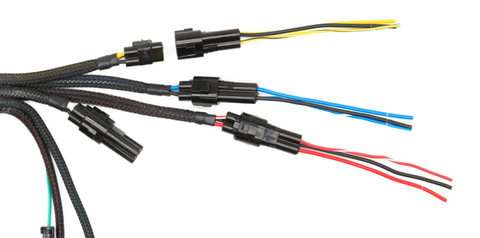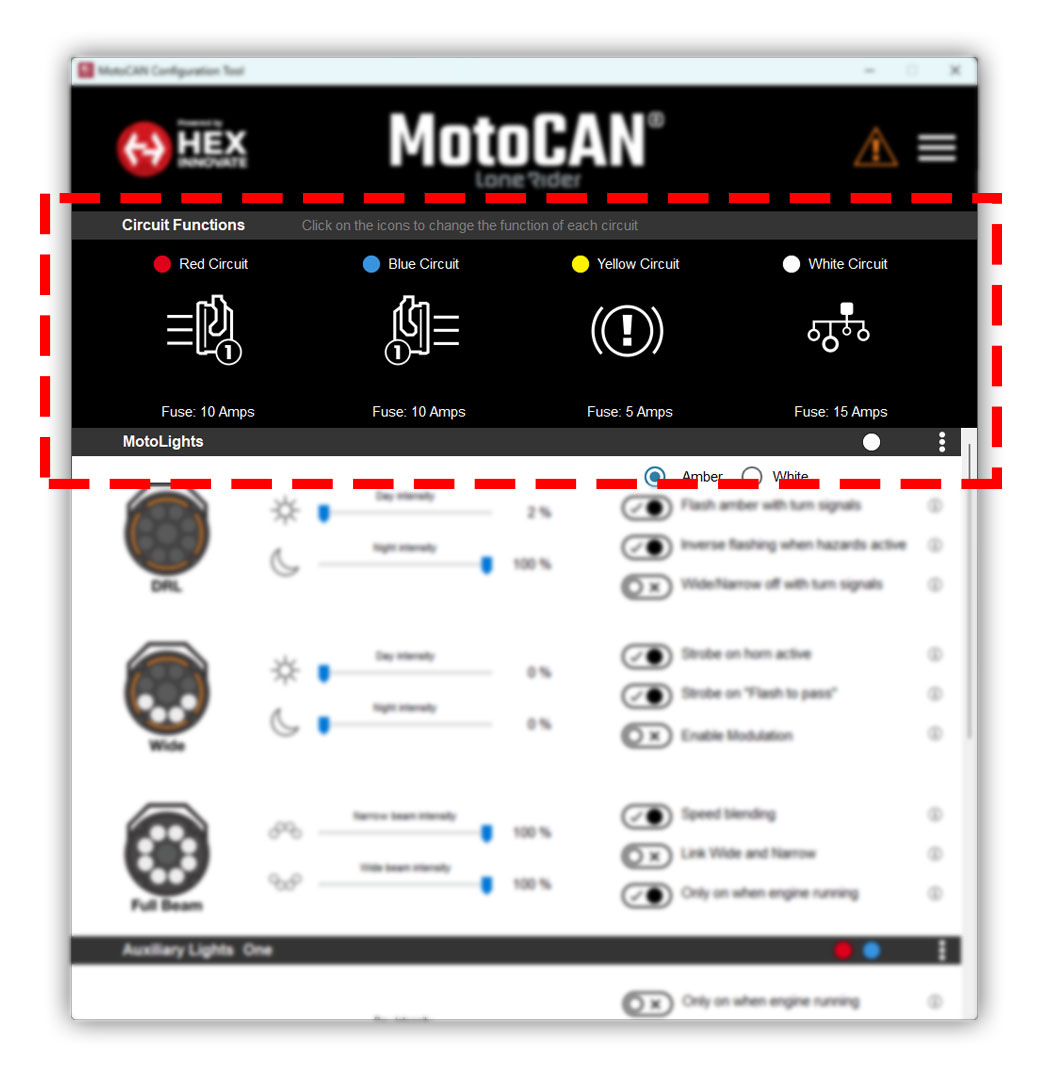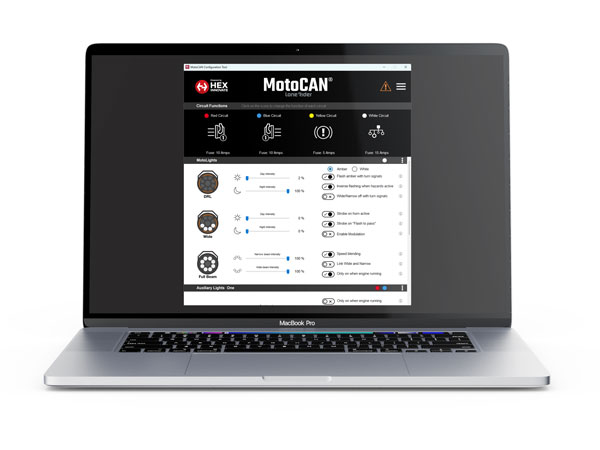MotoCan Installation for Honda [LR0447]
How to install the MotoCAN for Honda Bikes

Installation guide:
This is a step by step guide to installing the MotoCAN for Honda Bikes. The following bikes are supported:
- CRF1100 Africa Twin (2020+)
STEP 1:
Install your MotoCAN onto your Motorcycle
LOCATE YOUR BIKE'S BATTERY & THE IMU CONNECTOR
Required tools:
- 5mm allen key
- 8mm spanner
- 10mm spanner
- Possibly a star screwdriver (depending on how you loosen your battery terminals)
The battery is located on the left-hand side of the Africa Twin, under the tool box. The tool box has to be removed to expose the battery terminals.
(i) This is done by removing the two bolts using the 5mm allen key (yellow).

(ii) Disconnect the battery cables. ALWAYS disconnect the Negative first and reconnect it last. In doing so, you will prevent possible short circuits if a tool connected to the positive terminal touches the metal frame of the motorcycle.
The IMU connector is located under the rear section of the tank.
(iii) You need to remove both the rider and pillion seats.
(iv) Remove the four bolts using the 5mm allen key (yellow).

(v) The plastic fairing on the sides is held in place by a plastic clip. Loosen the fairing by pulling it away from the bike’s frame (see green markers).
(vi) This exposes two more bolts that will be removed using the 5mm allen key (yellow).
(vii) Remove the 10mm bolt that is securing the tank (blue).

(viii) Remove two plastic bits that were held in place the bolts removed in the steps above (yellow). This exposes the tank mounting bracket that needs to be removed.
(ix) Remove the four 8mm bolts that are securing the bracket. Next, gently lift the rear off the tank and remove the bracket.

STEP 2:
PLUG THE MotoCAN INTO THE CAN-BUS
Once you have completed the steps above, if you look under the tank you will see the IMU connector.
(x) using the connector on the MotoCAN as reference, note the tab that has to be depressed to remove the IMU connector (this is on the left side).
(xi) Connect the MotoCAN to both the IMU as well as the harness you just unplugged. The MotoCAN should now be connected between the IMU and the bike’s harness connector.



STEP 3:
ROUTE AND CONNECT THE BATTERY WIRES
The battery cables need to be routed on the left side of the bike.
Tip: Open the fuse housing and remove the fuse (this creates a smaller footprint and the cable and fuse housing can be routed through tighter spaces with greater ease).

(i) connect the battery cables (orange with inline fuse) to the positive of the battery and the brown wire to the negative of the battery.
Tip: Connect the positive terminal first and the negative one last.
(ii) remember to replace the fuse and fuse cover.
(iii) carefully route the wires so the fuse holder can be tucked away above the battery. The fuse holder will prevent the tool box from fitting correctly if it is left in front of the battery.

STEP 4:
CONNECT ACCESSORIES USING COLOUR CODING
- 3 x Two wire stub connectors (Orange)
- 3 x Terminal Wires (Orange)
- 3 x Blanking seals
If your auxiliary lights have three wires change the two-wire stub connector into a three-wire see the image below. If your auxiliary lights have two wires use the two-wire stub connectors for accessories that have power and ground wires only.
If you are not going to use one or more of the circuit functions it is recommended that you install a blanking plug over the unused output. The MotoCAN product contains three blanking plugs.

Insert blanking seal to use as a two-wire stub connector
Insert terminal wire to use as a three-wire stub connector


Connect the terminals of the high-power stub connectors to the correct female terminals on the MotoCAN.
Connect the spotlight’s ground wire to the ground wire of the stub connector.
If you are installing spotlights equipped with a third wire for light-intensity control, connect the spotlight control wire to the control wire of the stub connector. If the spotlight only has two wires, use the two wire stub connectors.

If you received four different coloured wires, please note the colour-coding on the output wires must match the colours in the output configuration you select from the MotoCAN circuit function software. Red to red, yellow to yellow, etc. Black wire is Battery Negative and the Red, Blue,Yellow and White are the Positive Supply.



STEP 5:
DOWNLOAD, INSTALL & CONFIGURE THE SOFTWARE
CLICK HERE TO DOWNLOAD THE SOFTWARE
Please download the 'Quick Start Manual PDF' from the software page for the most up-to-date and comprehensive installation and configuration information.

STEP 6:
TEST THE INSTALLATION
Most newly installed accessories can be tested simply with the ignition “ON”, but some brake functions will require the bike to be in motion and traveling above a certain speed. For example, emergency braking requires deceleration of more than 21km/h/s (kilometres per hour per second).
SAFETY NOTICE: Test and check your installations and accessories in a safe, controlled environment. Caution is advised at all times. Extra vigilance is required when testing new features or accessories. You do so at your own risk.
DISCLAIMER: MotoCAN is not liable for any injury or damage howsoever caused and all products and services are used at your own risk.
STEP 7:
COMPLETE THE INSTALLATION
Complete the installation by:
- Ensuring all cables and cable harnesses are secure and that the MotoCAN has a snug, secure place to rest (use the provided cable ties where required)
- Replacing the parts and screws that were removed in Step 2 (in the reverse order)
- Finally, give your installation a final inspection and a final test.
Well done! Now finish that beer whilst you read the important information in the User Manual on how to set the brightness of your lights using your bike’s handlebar controls. Did you know you can also toggle your accessory lights on and off using your handlebar controls?
Top Tip: Skip the rest and read section 5 of the MotoCAN User Manual!
SKU: LR-HND-002 (Sahara)- PN.: LR0447
23OCT2024

